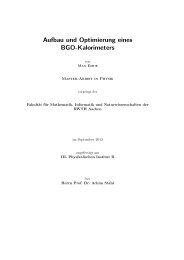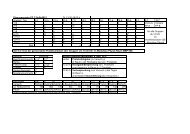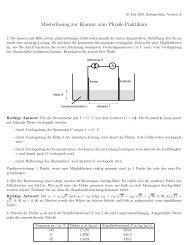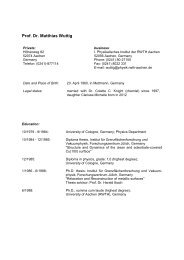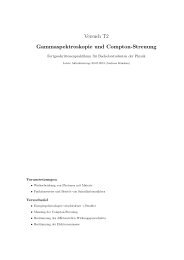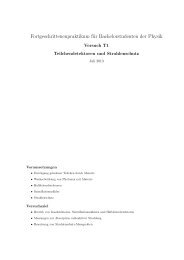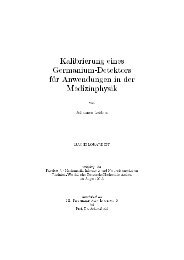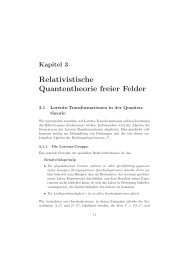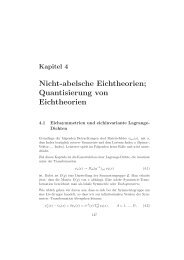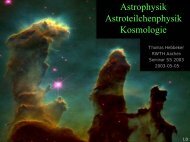Model Independent Search for Deviations from the Standard Model ...
Model Independent Search for Deviations from the Standard Model ...
Model Independent Search for Deviations from the Standard Model ...
You also want an ePaper? Increase the reach of your titles
YUMPU automatically turns print PDFs into web optimized ePapers that Google loves.
Chapter 10<br />
Conclusion<br />
In this diploma <strong>the</strong>sis, <strong>the</strong> rst <strong>Model</strong> <strong>Independent</strong> <strong>Search</strong> <strong>for</strong> New Physics during DØ<br />
Run II has been per<strong>for</strong>med successfully.<br />
In this apporach, all events detected with at least one electron/muon and a certain amount<br />
of Missing Transverse Energy are selected. Following <strong>the</strong> specic topology of an event, exclusive<br />
and inclusive event classes are constructed, e.g. 1ν 1µ 3jets(+X). This results<br />
in a muon sample of 16 dierent particle combination and an electron sample of 17<br />
combinations. In a rst step, <strong>the</strong> total number of events per class is compared to <strong>the</strong><br />
<strong>Standard</strong> <strong>Model</strong> prediction using Monte Carlo simulations. In a second step, <strong>the</strong>se event<br />
classes are systematically scanned <strong>for</strong> deviations <strong>from</strong> <strong>the</strong> <strong>Standard</strong> <strong>Model</strong> by examining<br />
<strong>the</strong> variable ∑ p T and <strong>the</strong> MET distribution. There<strong>for</strong>e, a special <strong>Search</strong> Algorithm has<br />
been developed, based on <strong>the</strong> work of <strong>for</strong>mer <strong>Model</strong> <strong>Independent</strong> analyses ([18], [19] and<br />
[20]). This algorithm identies <strong>the</strong> region with <strong>the</strong> greatest discrepancy between data and<br />
<strong>Standard</strong> <strong>Model</strong> prediction, calculates <strong>the</strong> probablity of this deviation and tests its general<br />
signicance. Statistical,aswellassystematicuncertaintiesareimplementedinthisroutine.<br />
In <strong>the</strong> analysis presented here, a data set corresponding to an integrated luminosity<br />
L ≈ 220 pb of p¯p-collisions is considered. These data were recorded by <strong>the</strong> DØ experiment<br />
between −1 July 2002 and April 2004 with a center of mass energy of 1.96 TeV.<br />
In <strong>the</strong> comparison of <strong>the</strong> total number of events per class, <strong>the</strong> general agreement between<br />
data and <strong>Standard</strong> <strong>Model</strong> prediction is good. This leads to <strong>the</strong> conclusion that <strong>the</strong> DØexperimentisunderstoodwelland<strong>the</strong>detectorsimulationreproducesmostof<strong>the</strong><strong>Standard</strong><br />
<strong>Model</strong>-processes corretly. All observed deviations could be explained with detector eects<br />
not simulated properly in <strong>the</strong> Monte Carlo simulations. Never<strong>the</strong>less, <strong>the</strong> deviations already<br />
observed at this level should be taken seriously in order to improve <strong>the</strong> description<br />
of <strong>the</strong> data.<br />
What concerns <strong>the</strong> dierential cross section, in <strong>the</strong> muon sample, 5 event classes with signicant<br />
deviations have been found by <strong>the</strong> <strong>Search</strong> Algorithm {1ν 1µ(+X), 1ν 1µ 1j(+X),<br />
1ν 2µ(+X), 1ν 1µ 2j(+X) and 1ν 1µ 1e 2j(+X)}. In <strong>the</strong> electron sample, 4 event classes<br />
with signicant deviations have been found {1ν1e(+X), 1ν2e(+X), 1ν1µ1e(+X) and<br />
1ν1µ1e2j(+X)}. Hence, three classes show discrepancies in both data samples, which<br />
intensies <strong>the</strong> disagreement fur<strong>the</strong>r.




